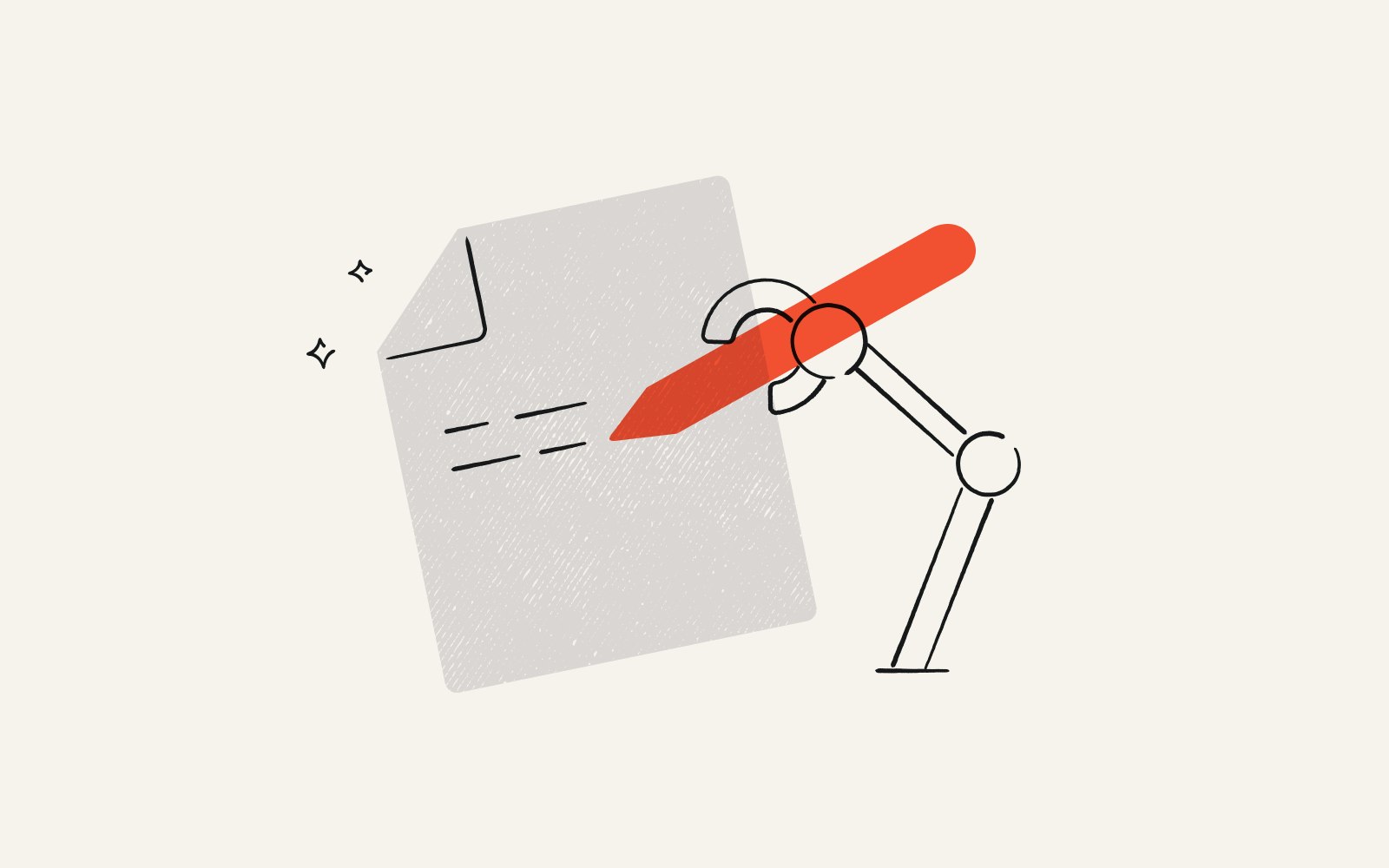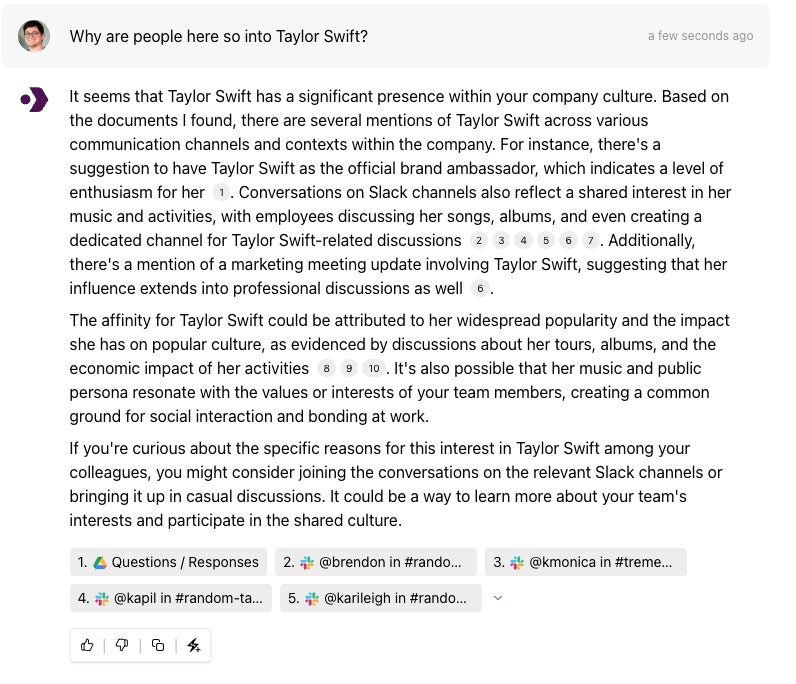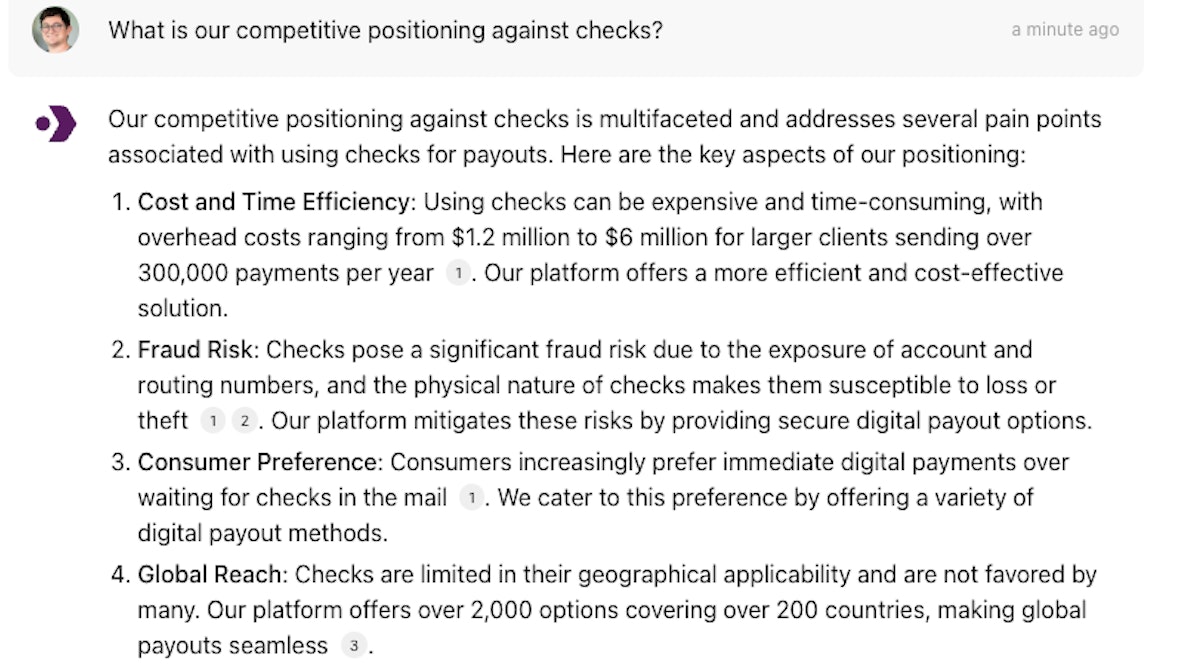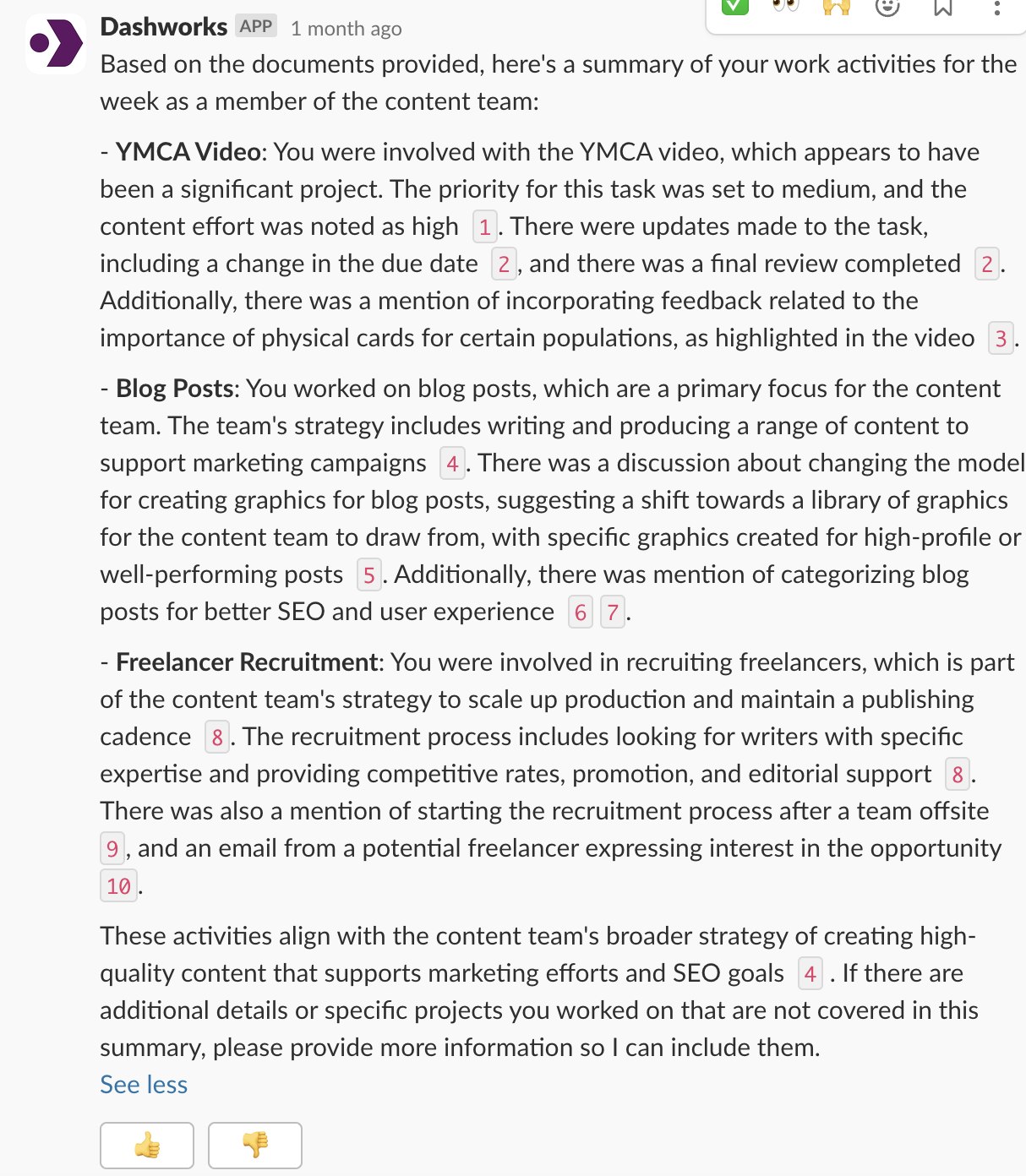AI gives us time to write more. Writing more makes AI more useful.
By Kate Monica●5 min. read●Aug 12, 2025

At Tremendous, we use AI to help us write code, create blog posts, answer questions, and brainstorm, like most tech-forward companies. But we’ve also been using it to further organize and enrich our high-documentation, low-meeting work culture.
We use Dashwork’s DashAI, an AI assistant that helps employees find the internal company knowledge they need to make decisions. It’s one of a few AI platforms that search through and surface relevant company knowledge. DashAI aggregates information from the platforms we use every day, including Slack, Notion, HubSpot, and Asana. The result is an AI capable of combing through all internal company knowledge to surface exactly the conversation, data point, or document we need to answer our questions.
Like we said in our previous blog post on the topic, the biggest benefits of a high-doc, low-meeting culture are that it allows us to:
Get things done
Make thoughtful decisions
Move long-term fast
Learn from successes
Reduce the hidden costs of meetings
Since integrating AI into our tech stack, we’ve been able to do all of these things more and better. As an added benefit, each tenet of our workplace design positions us to feed and curate a more useful and knowledgeable AI.
How AI makes our working lives way easier
There are hundreds of ways we benefit from our AI knowledge assistant. But there are three common use cases where teams have notably benefitted from an AI that can sift through all our internal documents, project management apps, and conversations for us.
Onboarding new hires
We invest a lot of time in documentation, resulting in rich training data for our AI. It comes in handy when a new employee joins the company.
While we invite and expect new hires to ask tenured employees questions, DashAI allows them to do plenty of self-guided learning about the company, our way of working, and the current state of various projects and strategies. They can get all the information they need, and they only rarely need to interrupt the workflows of other employees to ask questions.

We still have live onboarding sessions, but they largely consist of brief Q&A’s with the head of each department. With help from AI and our existing documentation, we can avoid the dreaded day-long onboarding slog.
Because new hires can find most of the information they need themselves, they can start contributing meaningfully to projects quickly. Most execute on a significant deliverable within their first week with the company.
Scaling initiatives that are working out well
Existing employees can also get up to speed quicker with help from AI. For instance, if someone’s asked to pitch in on an initiative in progress, they can ask DashAI, “What do I need to know about the web update project?”, and they’ll receive the most relevant details on the project from Slack, Notion, and Asana.
This eliminates the need for a project onboarding meeting or a long discussion over Slack with the employees who are already involved. Rather than interrupting the workdays of several employees to get a handful up to speed, a new contributor can get the answers they need on their own.
Of course, if there are questions unanswered in the docs, we can and do talk. We have plenty free time for spontaneous discussions because there are so few meetings on our calendar.
Continual learning
Our commitment to documentation makes it easier for both new and tenured employees alike to learn from each other. If someone wants to know the ‘why’ and ‘how’ of an impactful decision, they need only pull up the public strategy doc in our Notion database, or reread the Slack thread where the decision was made.
Unfortunately, the built-in search functions of these platforms are lacking. We’ve all struggled to find the right brief in Notion, contact in HubSpot, or thread in Slack. Too often, we end up basing decisions on outdated info, or bugging colleagues to find what we need.
DashAI has helped us scale company knowledge even faster and more accurately. It simply provides better answers faster than any app’s built-in search, and in fact searches across several apps to provide a more comprehensive answer to most questions.
When search tools render inconsistent or incomplete results, people are more apt to lose the self-service habit. Because our AI consistently delivers complete and accurate answers, it encourages and rewards employees for autonomous learning.

Instead of defaulting to asking a colleague, many of us have turned to the DashAI Slack bot. So, someone can just ask the bot about our relationship with a particular client or prospect?” and they’ll get accurate info from across several sources.
Our AI will outline, in a clear, bulleted format, rationale from several Slack threads and Notion docs that justify and explain the reasons for this change in direction. Allowing AI to surface things knowledge is both more timely, more consistent, and more reliable than asking colleagues.
How our high-doc culture makes our AI smarter
Our approach to documentation does come with a cost. It takes a lot of time.
But our dedication to documentation and public discourse in Slack and Notion is the reason our internal AI is so effective.
The most significant time-saving benefit of writing so much is that we have way fewer meetings than most other companies. Even people managers sometimes have full days without a single scheduled interruption.
It’s part of our identity as a builder culture: everyone, from ICs to executives, does heads-down work. So everybody needs large chunks of focus time.
This approach has been hugely beneficial for training our AI. So much valuable information is lost to the ether in live meetings. Someone may recommend a great idea, an important data point to track, or valuable rationale for changing direction. Absent good note-taking, nobody who was in the room will hear it, and those who were will probably forget soon enough.
Because we’re in fewer meetings, the vast majority of questions, answers, information sharing, and brainstorming take place over Slack and Notion.
It’s important to note our AI can’t read our private DMs. In theory, this could be a stumbling block: the AI could lose out on troves of information shared between colleagues. But this isn’t a big problem for us, because our modus operandi has been public-by-default since well before we adopted DashAI.
Public-by-default means we encourage everyone to communicate in public channels as often as possible, so most discussions and documents are visible to everyone. That way, we can all get a birds-eye view of what’s happening with different projects, answer each other’s questions, and learn how various parts of the business work. It also reduces the friction of waiting for and granting access.
As a result, if we ask DashAI, “Which vendor did we decide to go with for tracking tagless analytics?”, it will surface the conversation where we batted around ideas for which vendor to go with and why we ultimately landed on FullStory.
The virtuous cycle
Intentionality is one of our core values. To put it into practice, we must diligently track knowledge, ideas, and arguments.
Whether we’re suggesting a new initiative or outlining a strategy, our first step is to walk through the problem we’re solving, the other options we considered, and the ‘why’ behind the recommended approach.
Because we write everything down, we’ve essentially built a living transcript of all of our ideas and thought processes from which the AI can learn.
We can ask DashAI “What’s our content strategy?”; “What did I work on this week?”; “What events are we considering attending this year?”; “When did we first talk to Client X”; “How many open positions are we hiring for?” – and on and on.
And because all of this documentation is (sometimes painstakingly) thorough, DashAI can do more than spit out a list of initiatives for the year. It can tell us the thinking behind each project, the goals and outstanding questions related to it, and a detailed plan for how we intend to execute — and then link to relevant docs for deeper review.
The output from DashAI detailed, so the decisions we make based on these answers are better informed. This ensures we can make more thoughtful decisions.
In this way, our approach to making thoughtful decisions creates a virtuous cycle: we’re thorough in our documentation, and as a result, the AI is thorough in its output, so the decisions we make based on these answers are better informed.

Why you should start using AI to organize your workplace now
AI magnifies the benefits of a high-doc, low-meeting work culture in several respects. Better still, the more we adhere to the principles of our high-doc culture, the more comprehensive the knowledge of our AI.
Obviously, as of early 2024, AI has many areas ripe for improvement. The potential of the technology is massive compared to its current capabilities. But there are two reasons to integrate AI into your daily activities now, despite its shortcomings:
Getting accustomed to leveraging AI now will make you better at using it habitually in the future, when it will be a starkly differentiating advantage.
Even though there is room for improvement, AI in its current form is well suited for recall, summarization, and information sharing, which is all you need it to be able to do to improve workplace productivity.
If you’re an advocate of more writing and less meeting, perhaps you can make the case for a culture shift by pointing to the substantial benefits of giving AI more to work with. If you’re already in such an environment, consider using a tool like DashAI to make the most of what you’ve already got across your work stack.